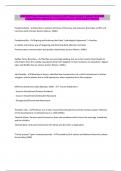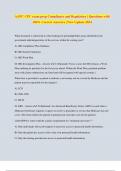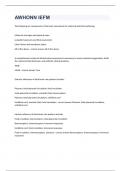AMFTRB Exam | Questions & Answers (100 %Score) Latest Updated 2024/2025
Comprehensive Questions A+ Graded Answers | With Expert Solutions
Psuedomutality - ✔✔describes a systemic pretense of harmony and closeness that hides conflict and
interferes with intimacy (Lyman Wynne, 1940s)
Psuedohostility - ✔✔Arguing and bickering that hides "pathological alignments" in families
A volatile and intense way of disguising and distorting both affection and splits
Prevents open communication and quality relationships (Lyman Wynne, 1940s)
Rubber-Fence Boundary - ✔✔Families are seemingly yielding, but are in fact nearly impermeable to
information from the outside; boundaries bind them together in their resistance to separation" Appear
open and flexible but are closed. (Lyman Wynne, 1940s)
John Bowlby - ✔✔Attachment theory. Identified the characteristics of a child's attachment to his/her
caregiver and the phases that a child experiences when separated from the caregiver.
Different attachment styles (Bowlby, 1949) - ✔✔- Secure Attachment
- Insecure Attachment (Anxious-Avoidant)
- Insecure Attachment (Ambivalent-Resistant)
- Disorganized/Disoriented Attachment
Theodore Lidz - ✔✔Professor out of Yale, researched schizophrenia and the marital couple's influence
on the development of schizophrenia in a child (1950s)
-Marital Schism: Parents overly focused on their own problems which harms the marriage, individuals,
and the children.
-Marital Skew: One parent dominates the family and the other is dependent.
"Family process" (peer-reviewed journal) - ✔✔Founded by Don Jackson and Nathan Ackerman, edited
by Jay Haley (1962)
,Mental Research Institute (MRI) - ✔✔MRI; Mental Research Institute A center for the study of families in
Palo, Alto, CA whose researchers and practioners- Bateson, Jackson, Satir, Weakland, Fry, and Haley
studied schizophrenia and family interactions, communication, and cybernetic theory. They emphasized
process and interactional sequences rather than structure, and distinguished between first-order and
second-order change. They developed a version of Brief Family Therapy based on the notion that the
"problem" or tx focus, stems from the failed solution previously attempted by the family.
Norbert Wiener - ✔✔Coined the term and theory "cybernetics"
General Systems Theory - ✔✔living systems are like cybernetic systems that are equipped w/ complex
feed systems capable of maintaining a desired state of affairs (i.e. homeostasis) → leads to Bowlby's
system of behavior control
Double bind theory - ✔✔distinct pattern of communication in which one individual receives
contradictory commands from which there is no escape (lose, lose situation)
6 characteristic of a double bind - ✔✔1) Communication involves 2 or more people who are involved in
an important emotional relationship.
2) The pattern of communication and the relationship is a repeated experience.
3) The communication involves a primary negative injunction--or a command not to do (some act) or not
to NOT do (some act), either of which come with a threat of punishment.
4) A second abstract injunction is given that contradicts the primary injunction but at a more abstract
level and is usually nonverbal. This also occurs under the threat of punishment.
5) A third negative injunction both demands a response and prevents escape, effectively binding the
recipient to the environment in which these patterns exist.
6) When the above double bind messages have been communicated enough times, the individual has
become conditioned which no longer requires all of the above mentioned criteria to be present in order
to elicit the same intensity in response (panic, rage, schizophrenia).
Bertrand Russell - ✔✔Theory of Logical Types
Ludwig von Bertalanffy - ✔✔General Systems Theory
,Milton Erickson - ✔✔Hypnosis and paradox
Gregory Bateson - ✔✔Human Communication Processes (influenced by Russell, Von Bertalanffy,
Wiener, Erickson)
MRI Systemic Therapy - ✔✔
Strategic Family Therapy - ✔✔Jay Haley
Emphasizes change techniques over theory. Influenced by Milton Erickson
Therapist is very directive, especially useful with change-resistant families
Techniques: Take charge role, directives, paradoxical directives, ordeals, out-positioning, reframing
Milan Systemic Family Therapy - ✔✔A theory and therapeutic model influenced by Bateson and the MRI
Group, originally developed in Italy by Selvini Palazzoli, Boscolo, Cecchin, and Prata. The primary
techniques associated with the early Milan group were rituals and positive connotations. The Milan
Group split in the early 1980s with Selvini Palazzoli and Prata forming one group, adhering to the
strategic model and developing a ritualistic technique, invariant prescription, to counteract the dirty
game, or power struggle between the parents and their child. Boscolo and Cecchin moved away from
the strategic approach, developing a collaborative style of therapy. In this model, problems are
maintained when the family holds to an old epistemology that does not fit its current circumstance. The
therapist introduces new information indirectly by asking questions and the family solves problems
themselves as they develop a new epistemology. The therapist/client interactions within the session are
the treatment. In their interviews they displayed a curious attitude about the family and the meanings
they derived from their experiences and interchanges.
General Systems Theory definition - ✔✔GST proposed that all living systems share universal
characteristics. Fundamental principle is idea that the whole of the system is more than the sum of its
parts. To understand the system as a whole, must understand the dynamic, circular functioning between
the parts.
Cybernetics - ✔✔the study of information processing, feedback, and control in communication systems
Boundaries - ✔✔theoretical lines of demarcation in a family that define a system as an entity and
separate the subsystems from one another and the system from its environment.
, Boundary Interface - ✔✔The regions between each subsystem of the family and between the family and
the supra-system. In family systems therapy this interface is referred to as the familial boundary.
Familial Boundary - ✔✔the term used to represent the concept of Boundary Interface within literature
of FT
Open systems - ✔✔interact regularly with the environment with relatively no inhibition
Jay Haley - ✔✔Strategic Family Therapy
founding editor of 1st journal in family therapy
schism (Theodore Lidz) - ✔✔family division into competing groups
Adlerian Family Therapy - ✔✔An approach that is based on the premise that parents and children often
become locked in repetitive, negative interactions based on mistaken goals that motivate all parties
involved.
"stuck family" (Adlerian) - ✔✔parents assume roles based on their expectations of the children
strength of Bowen Family Therapy - ✔✔attention upon past family interaction as a means by which to
avoid future problems
Hermeneutics - ✔✔the interpretation of meaning
CBT Therapy is also known as... - ✔✔"reality therapy"
Brief Therapy (earliest model) was developed by... - ✔✔Milton Erickson
the genogram was developed/popularized by BLANK & BLANK - ✔✔Monica McGoldrick & Randy Gerson






